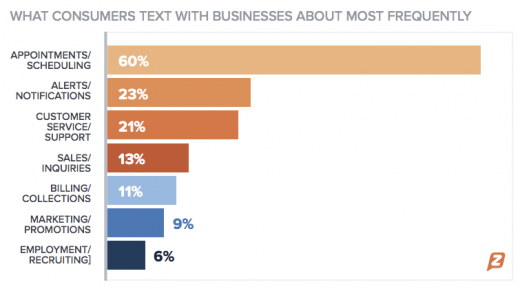New survey: Consumers are texting to businesses that aren’t set up to respond
The report, by texting solution provider Zipwhip, surveyed consumers and businesses about their attitudes toward this 25-year-old, omnipresent cell phone tech.
Over half of consumers — 58 percent — have responded to a missed phone call from a business with a SMS/MMS text message — but those businesses were not yet set up to handle such text conversations.
“Those messages,” said business texting provider Zipwhip CMO Scott Heimes, “are sent into the abyss.”
This missed marketing opportunity is a key finding in Zipwhip’s “2019 State of Texting Report” (free, registration required), which is out today and which he described as “the first comprehensive research on the topic.”
“Particularly frustrated.” Additionally, the report found that 75 percent of consumers “are particularly frustrated when they cannot respond to a text from a business,” Heimes told me via email, “such as to reschedule an appointment following a reminder notification.” Such messages are often short-code text, where businesses can only send but not receive.
While Zipwhip obviously has a horse in this race and this report is part of the company’s pitch for its texting solutions, the survey presents some interesting perspectives on a 25-year-old technology that is available on every modern smartphone.
The survey was conducted with a SurveyMonkey-supplied panel of US-based 1000 consumers and 1000 businesses. Businesses ranged in size from under 25 employees to over 50,000.
Comparison to email. Thirty-nine percent of responding businesses use some form of texting to communicate with their customers, but inside that figure is 13 percent that only use messaging tools like one-way short code messaging.
The report indicates that texting is more popular than that other venerable form of electronic communication, emailing. On average, the report said, consumers send 15 texts daily versus a dozen emails, plus Zipwhip makes the point that virtually all text messages are opened.

The survey found that 74 percent of responding consumers reported no unread texts, compared to only 17 percent who said they had zero unread emails. Seventy-four percent also said they respond to a text message from a business within an hour, compared to 41 percent who have the same response time for an email from a business.
Top use cases for businesses. Seventy-six percent of responding consumers said they’ve received some kind of text message from a business. Sixty-seven percent would prefer texting about appointments or reminders, compared to receiving that info via email or phone. In fact, scheduling is the top use case for businesses to employ texting, says 56 percent of responding businesses, while 54 percent cite customer service and support.
The survey didn’t indicate what percentage of those text conversations were generated on the business end by text-communicating bots, and what percentage featured an actual human. In any case, the report recommends Zipwhip’s position: until chatbots are much better, a texting bot can handle some rudimentary inquiries, but should be able to handle off to a real person when required.
Why you should care. Sixty-one percent of respondents indicated that they wouldn’t install a new app to communicate with a business, which means that marketers are passing up an omnipresent, highly utilized channel to communicate with every smartphone user if they aren’t set up for texting with customers and would-be customers.
This story first appeared on MarTech Today. For more on marketing technology, click here.
Marketing Land – Internet Marketing News, Strategies & Tips
(25)



